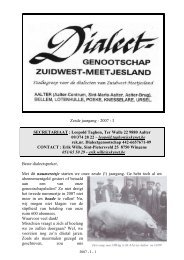- Page 1:
HET DIALECTENBOEK 6 VAN DE STREEK D
- Page 4 and 5:
© Stichting Nederlandse Dialecten
- Page 6 and 7:
Het dialectenboek Het dialectenboek
- Page 9 and 10:
INHOUDSOPGAVE Voorwoord 9 Magda Dev
- Page 11:
OOST-VLAANDEREN 303 Veronique De Ti
- Page 14 and 15:
oots en onthult ons een rariteitenk
- Page 16 and 17:
wordt. 1 Het is haar bedoeling een
- Page 18 and 19:
de totstandkoming en vastlegging va
- Page 21 and 22:
Magda Devos HET LANDSCHAP IN EIGENN
- Page 23 and 24:
verschijnsel dat dienst doet als ru
- Page 25 and 26:
woonplaats, is het een onmogelijke
- Page 27 and 28:
geen zekerheid over de aard en het
- Page 29 and 30:
De kaartjes in het artikel zijn ont
- Page 31 and 32:
Beide verschijnen ze onder een hele
- Page 33 and 34:
asbenamingen: enerzijds het erfwoor
- Page 35 and 36:
of modder. Deze groep van moeraswoo
- Page 37 and 38:
Zompel is in oorsprong een verklein
- Page 39 and 40:
Het woord gaver is ons enkel dankzi
- Page 41 and 42:
2.3. Poelen en plassen De Nederland
- Page 43 and 44:
Meer, net zoals de weidenaam meers
- Page 45 and 46:
De waternamen waal, weel en wiel sl
- Page 47 and 48:
'kouter' in familienamen — kouter
- Page 49 and 50:
en meers is daarbij duidelijk het p
- Page 51 and 52:
zich in het familienamenbestand in
- Page 53 and 54:
omvatten graasland, houtgewas en we
- Page 55 and 56:
kunnen zijn naar de Brusselse gemee
- Page 57:
Gysseling, M., 'Oude toponiemen te
- Page 60 and 61:
eens ronduit gevraagd, toen ik klei
- Page 62 and 63:
Ook leuk: Nomen est omen. Wij bij h
- Page 64 and 65:
Schrijfwijze is één. Uitspraak is
- Page 67 and 68:
Jan Wauters DE ECHOPUT UIT MIJN KIN
- Page 69 and 70:
Vliet voor schepen in herstelling.
- Page 71 and 72:
zullen worden. Tot meer begrip voor
- Page 73 and 74:
Stel u geen koppel vredesduifjes vo
- Page 75 and 76:
nood aan een heel eigen huistaal, e
- Page 77:
Moge God en Gerrit Komrij dat verho
- Page 80 and 81:
het opgroeien komt men spontaan in
- Page 82 and 83:
meteen herkenbaar; de familienaam D
- Page 84 and 85:
samenstellingen of afleidingen. Ind
- Page 86 and 87:
umlaut" heet, maakte van de Oudnede
- Page 88 and 89:
klankevolutie: in het noordoosten,
- Page 90 and 91:
KAART 3: Familienamen Wouter s/Wolt
- Page 92 and 93:
KAART 4: Familienamen met oud/old/a
- Page 94 and 95:
Noten 1. Bij een populair Limburgs
- Page 96 and 97:
Bibliografie Debrabandere, F., Woor
- Page 98 and 99:
Deze feiten van v en z aan het begi
- Page 100 and 101:
Fisser Flap Fleer Fleeren,van Fliet
- Page 102 and 103:
Hoe dat ook zij - het zou van geval
- Page 104 and 105:
Zo bekend als het buiten Friesland
- Page 106 and 107:
dergelijke) de combinatie van de a
- Page 108 and 109:
ervaren worden: er ontstonden namen
- Page 110 and 111:
zin van: handelaar, verkooper, leve
- Page 112 and 113:
Noten 0. De redactie - en Veronique
- Page 115 and 116:
Siemon Reker STRUIZENGA, BOYKEMA EN
- Page 117 and 118:
identiek uitgesproken, net als Huiz
- Page 119 and 120:
KAART 2: De familienaam Buikema Bei
- Page 121 and 122:
Tot besluit nog even terug naar het
- Page 123 and 124:
Weistra Westra Wierstra Wijkstra Wi
- Page 125 and 126:
Met woorden als Damster en Delfzijl
- Page 127 and 128:
Aty-namen treffen we duidelijk mind
- Page 129 and 130:
-4 oorspronkelijk kleinere van verd
- Page 131 and 132:
Noten 0. De redactie van deze bunde
- Page 133 and 134:
Siemon Reker en Harry Slot DRENTHE
- Page 135 and 136:
Van deze namen en hun dragersaantal
- Page 137 and 138:
waarvan "tenminste 50% van de drage
- Page 139 and 140:
3. Van der Haar en anderen over -ig
- Page 141 and 142:
De uitspraak van koning is eenduidi
- Page 143 and 144:
Het WDD maakt het ons niet gemakkel
- Page 145 and 146:
6. Scheper, Knigge en Moek Het WNT
- Page 147 and 148:
Een vrij veel voorkomende Drentse f
- Page 149 and 150:
Noten 0. Diverse personen - naast d
- Page 151 and 152:
Harrie Scholtmeijer OVERIJSSEL A. W
- Page 153 and 154:
tegenover. Kloeke (1954) beschouwde
- Page 155 and 156:
Zuiderzee-inpolderingen was de acht
- Page 157 and 158: André Hottenhuis DE NIJE, GROTE HO
- Page 159 and 160: 1. Hoo loat ie oe schrieven? De naa
- Page 161 and 162: kern Weerselo schrijven we Legtenbe
- Page 163 and 164: echter krab (ben). Het woord brumme
- Page 165 and 166: (Hellendoorn), Van Oortmerssen (Oot
- Page 167 and 168: In de oostelijke provincies komen w
- Page 169 and 170: die functie. Het woord rik voor afs
- Page 171 and 172: Een kuil of poel is in het dialect
- Page 173 and 174: A.H.G. Schaars GELDERLAND, EEN NAAM
- Page 175 and 176: JANSEN KAART 2: Het voorkomen van d
- Page 177 and 178: • 0.00— 0,99 £3 1,00—2,49
- Page 179 and 180: In 1947 komen blijkens kaart 5 de n
- Page 181 and 182: Standaardnederlands voorkomen, op g
- Page 183 and 184: waarvan slechts 3 keer in Bergh). D
- Page 185 and 186: KAART 9: Thuis en Thuys in 1993 De
- Page 187 and 188: Westerholt 36 8 Zutphen 16, Arnhem
- Page 189 and 190: Leendert Brouwer NOORD-HOLLAND, ZUI
- Page 191 and 192: inheemse namen tussen de frequente
- Page 193 and 194: plaatsnaam Zwieten (918-948 cop. ei
- Page 195 and 196: 2.4 Nu we in de microtoponymische s
- Page 197 and 198: 3.0 In Noordwest-Nederland valt een
- Page 199 and 200: een zelfstandig naamwoord in onderw
- Page 201 and 202: Met behulp van de dialectgeografie
- Page 203 and 204: Een groot deel van de Den-namen kom
- Page 205 and 206: o kunnen zijn, waarmee de naamdrage
- Page 207: Noord- en Zuid-Nederland: de opgave
- Page 211 and 212: Brabant, dat ook een stuk Zuid-Holl
- Page 213 and 214: Heeroma, K., Hollandse dialectstudi
- Page 215 and 216: Jan Berns VAN AALBRECHTSE EN BREUNE
- Page 217 and 218: dezen niets op, terwijl het bekend
- Page 219 and 220: voorbeelden, zoals vate (dialectisc
- Page 221 and 222: van Scherpenisse: 4 Serooskerke, Tu
- Page 223 and 224: Piet Vos NOORD-BRABANTSE FAMILIENAM
- Page 225 and 226: namen met meer dan 100 naamdragers,
- Page 227 and 228: 1967: 100 en 110 en Goossens 1978:
- Page 229 and 230: oosten van die lijn nog wel driekwa
- Page 231 and 232: KAART 2: 'ramaker': -de-/-j-/-0-, u
- Page 233 and 234: 3.1. De dialectwoorden en de famili
- Page 235 and 236: Mutsaers en Mutsaerts. Daarnaast zi
- Page 237 and 238: woordenboek (EDW) bij mutsel en gee
- Page 239 and 240: [moesjoet], mutsaardhout, mutsaards
- Page 241 and 242: Ton van de Wijngaard LIMBURGSE FAMI
- Page 243 and 244: Hetzelfde geldt ook voor de dialect
- Page 245 and 246: Sittard gegroepeerd en centraal in
- Page 247 and 248: Vaak zijn familienamen die zijn ont
- Page 249 and 250: nodig was, was het maken van spaakw
- Page 251 and 252: van Heerlen, Waubach, Eygelshoven,
- Page 253 and 254: ij de verklaring van deze groep fam
- Page 255 and 256: uit het midden en zuiden van de pro
- Page 257 and 258: Rob Belemans BELGISCH LIMBURG "HOE
- Page 259 and 260:
Canin. De atf/ee-klinkerwisseling t
- Page 261 and 262:
vinden is. In dat laatste gebied tr
- Page 263 and 264:
denkt hij aan een ontlening uit het
- Page 265 and 266:
Wie een familienaam ziet die verwij
- Page 267 and 268:
kuiper betekent en afgeleid is van
- Page 269 and 270:
ontrondingsproduct van de korte u u
- Page 271 and 272:
Aldeneik. Dat de dialecten de ontwi
- Page 273 and 274:
afkomstig van het gelijknamige West
- Page 275:
Noten 1. Deze aantallen werden ontl
- Page 278 and 279:
1. Fonologische kenmerken 1.1. De h
- Page 280 and 281:
meer voorkomt dan het weglaten van
- Page 282 and 283:
mate voor in de provincie. Als voor
- Page 284 and 285:
1.6. De uitgang -ng In tweelettergr
- Page 286 and 287:
werden, algemeen gebruikelijk moet
- Page 289 and 290:
Jacques Van Keymeulen DE 430 FREQUE
- Page 291 and 292:
2.1. Afstammingsnamen naar de vader
- Page 294 and 295:
3. Woonplaats- en herkomstnamen Bij
- Page 296 and 297:
gouwen), en Dekempeneer (
- Page 298 and 299:
=Mnl. voor Binche, H), Spinnoy (
- Page 300 and 301:
epaalt, wellicht ook beeldsnijder),
- Page 302 and 303:
umlaut, hoewel we dat in Brabant zo
- Page 304 and 305:
windbuil, opschepper), Crab, Craps
- Page 306 and 307:
Noten 1. Onze gegevens zijn gebasee
- Page 308 and 309:
2. Vroeger, hier en nu Door Oost-Vl
- Page 310 and 311:
namen - vaak zijn het dan namen van
- Page 312 and 313:
goed verspreid, en dat vindt zijn w
- Page 314 and 315:
naam dan als bijnaam en hij verwijs
- Page 316 and 317:
groenselaar, grasselaar en gruisela
- Page 318 and 319:
oostelijke boek-\ormen, en dat boek
- Page 320 and 321:
materiaal (opgevraagd in de jaren '
- Page 322 and 323:
de korte vorm van Notte- misschien
- Page 324 and 325:
Een andere benaming die in Vlaander
- Page 326 and 327:
een afleiding van poest(e) 'koestal
- Page 328 and 329:
de dialectkaart van de timmerman (k
- Page 330 and 331:
Noten 0. Diverse collega's waren in
- Page 332 and 333:
Teirlinck, I. , luid-Oostvlaandersc
- Page 334 and 335:
Joon(n)ekindt. In dat geval gaat he
- Page 336 and 337:
dubbelganger vindt in een perfect p
- Page 338 and 339:
usscop, gulde), maar u voor ;' in r
- Page 340 and 341:
hoort. Het huidige verspreidingsgeb
- Page 342 and 343:
heeft de variant Vandenbossche in d
- Page 344 and 345:
wegneemt dat ook elders, minder gec
- Page 346 and 347:
en Hongenae zijn zoals gezegd typis
- Page 348 and 349:
Een goede illustratie biedt ook de
- Page 350 and 351:
familienamen mondt dan ook onvermij
- Page 352 and 353:
Bibliografie De Bo, West-Vlaamsch i
- Page 354 and 355:
Duinkerke, maar ook van Calais. In
- Page 356 and 357:
KAART 1: Immigratie in Halluin in h
- Page 358 and 359:
West-Vlaanderen en westelijk Oost-V
- Page 360 and 361:
3. Autochtone Vlaamse familienamen
- Page 362 and 363:
Schre(e)jheere (zeldzaam in de omge
- Page 364 and 365:
sommige verwante namen in Frans-Vla
- Page 366 and 367:
Noten 1. http://geonome.metaphor.be
- Page 369 and 370:
Ann Marynissen WEGWIJZER NEDERLANDS
- Page 371 and 372:
met merendeels de Vlaamse plaats- e
- Page 373 and 374:
INLEIDINGEN EN METHODEN Een inleidi
- Page 375 and 376:
1.2. Microtoponymie, toponymische b
- Page 377 and 378:
2.2. Familienamen Debrabandere, F.,
- Page 379 and 380:
3. Andere namen Brok, H., Enkele bl
- Page 381:
ONDERWIJS Naamkunde wordt op dit og
- Page 384 and 385:
Al. PUBLICATIES LANDELIJK HANDBOEKE
- Page 386 and 387:
P. van Veen, i.s.m. N. van der Sijs
- Page 388 and 389:
Leuvense Bijdragen, sinds 1896. Het
- Page 390 and 391:
S.J.H. Reker, Omgekeerd is ook wat
- Page 392 and 393:
HULPMIDDELEN H. Bloemhoff, Fonologi
- Page 394 and 395:
K.D. Schönfeld Wichers, Woordenboe
- Page 396 and 397:
• Noord-Holland HANDBOEKEN, OVERZ
- Page 398 and 399:
• Zuid-Holland HANDBOEKEN, OVERZI
- Page 400 and 401:
H. Scholtmeijer, Zuidutrechts woord
- Page 402 and 403:
Van dialect tot turbotaal. De toeko
- Page 404 and 405:
lz. 28-30; nr. 6, blz. 23-25;Veldek
- Page 406 and 407:
• Antwerpen en Vlaams-Brabant HUL
- Page 408 and 409:
W. Pee, Het Westvlaams. In: West-Vl
- Page 411 and 412:
BI. LANDELIJKE INSTITUTEN EN INSTEL
- Page 413 and 414:
Koninklijke Bibliotheek Albert I Ke
- Page 415 and 416:
Stichting Het Drentse Boek Postbus
- Page 417 and 418:
• Zuid-Holland Stichting Streekta
- Page 419 and 420:
Veldeke-Limburg Secretariaat: Kerkw






